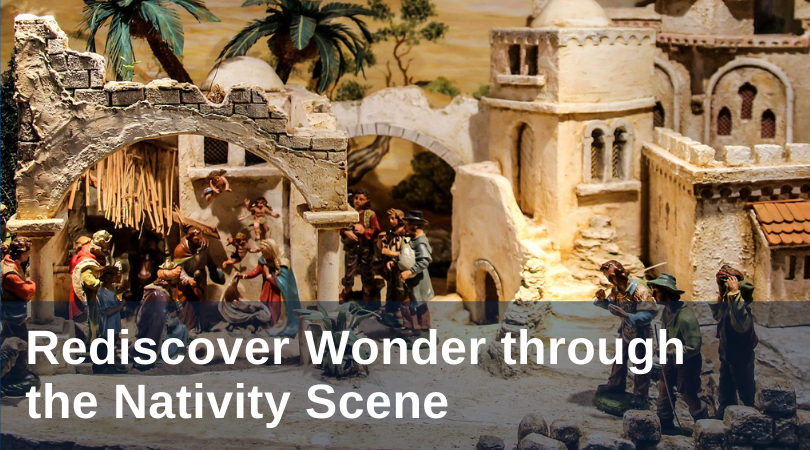
Take a moment to visualize the Nativity scene that was in your home as a child. Try to see it through your childhood eyes once again. What do you see? Do you remember that sense of wonder as you look at that familiar figurine of baby Jesus in the manger?
I have many early memories of being in awe of my family’s Nativity scene. My mom would make sure it was the first decoration to be set up. Before the adorable Christmas village came out of the attic, the little rundown stable needed to be put in its rightful place. I loved that little stable and often imagined what all the sheep and cows were saying to each other when Jesus arrived.
In a season full of lights and color and sparkle, we may notice that we still stop to gaze at the Nativity scene, which sometimes lacks the aesthetic appeal that Christmas has become known for. And yet we are still drawn in. As children we already could sense it. This is different. This is sacred. This is the beginning of the greatest love story. We understood the gravity of the Incarnation long before we could define it.
Last Advent, Pope Francis reflected on the wonder of the Nativity scene in his apostolic letter, Admirable Signum: “Why does the Christmas crèche arouse such wonder and move us so deeply? First, because it shows God’s tender love: the Creator of the universe lowered himself to take up our littleness” (§3). Pope Francis draws our attention to the manger. He reminds us that Jesus was born into this world and placed to sleep where food belonged. He does not want the idea of a baby in a manger to be lost on us; he wants us to see our Lord’s great love in the humility of his birth.
In contemplating Jesus’ Nativity, Dorothy Day wrote, “I’m so glad Jesus was born in a stable. Because my soul is so much like a stable. It’s poor and in unsatisfactory condition—yet I believe that if Jesus can be born in a stable, maybe he can also be born in me.” Dorothy’s words on the stable and Pope Francis’ reflections on the crèche offer us a new vision to reflect upon the Nativity scene, especially the manger. This Advent, we are invited to prepare ourselves to be the manger. Like its rough wood, we are insufficient to welcome the Savior into this world. But Jesus loves us in our smallness and in our simplicity. While our human hearts may not be fit for a king, we can still eagerly await his coming and offer all we are.
As you set up your Nativity scene this year, or as you contemplate other crèches throughout this season, allow yourself to see with eyes of childhood wonder. Pope Francis wishes this for us. He hopes for us to rediscover that wonder. Take a few moments to recall the Holy Father’s words as you gaze upon the space you have created to await the arrival of Christ.
Dear brothers and sisters, the Christmas crèche is part of the precious yet demanding process of passing on the faith. Beginning in childhood, and at every stage of our lives, it teaches us to contemplate Jesus, to experience God’s love for us, to feel and believe that God is with us and that we are with him, his children, brothers and sisters all, thanks to that Child who is the Son of God and the Son of the Virgin Mary. And to realize that in that knowledge we find true happiness. Like Saint Francis, may we open our hearts to this simple grace, so that from our wonderment a humble prayer may arise: a prayer of thanksgiving to God, who wished to share with us his all, and thus never to leave us alone. (AS, §10)
The McGrath Institute is inviting reflection on the Incarnation in a digital Advent and Christmas Crèche Calendar—a beautiful retrospective selection of crèches from around the world previously featured in our six on-campus exhibits. To subscribe to our daily reflection emails, visit our website!
Featured image by Gerhard G. via Pixabay



